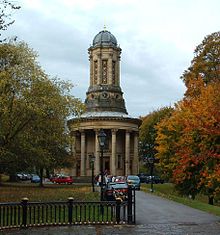Saltaire
- See also Saltaire, New York, United States.
| UNESCO World Heritage Site | |
|---|---|
 | |
| Criteria | Cultural: ii, iv |
| Reference | 1028 |
| Inscription | 2001 (25th Session) |

Saltaire is the name of a Victorian era model village in the metropolitan borough of Bradford, West Yorkshire, England, by the River Aire and the Leeds and Liverpool Canal. The village has also been declared as a World Heritage Site and is an Anchor Point of ERIH – the European Route of Industrial Heritage.
History
Saltaire was founded by Sir Titus Salt in 1853. The name of the village is a combination of the founder´s surname with the name of the river. Salt moved his entire business from Bradford to this site near Shipley partly to provide better arrangements for his workers than could be had in Bradford and partly to site his large textile mill by a canal and a railway. Salt employed the Bradford firm of Lockwood and Mawson as his architects.
A similar project had been started a few years earlier by Edward Akroyd at Copley, also in West Yorkshire. Other model villages predate Saltaire considerably, eg Robert Owen's village at New Lanark, Scotland, which was developed as early as the beginning of the 19th century, and is also a World Heritage Site.
Salt built neat stone houses (much better than the slums of Bradford), wash-houses with running water, bath-houses, a hospital, as well as an Institute for recreation and education, with a library, a reading room, a concert hall, billiard room, science laboratory and gymnasium. The village also provided almshouses, allotments, a park and a boathouse.
Sir Titus died in 1876 and is interred in the mausoleum adjacent to the Congregational Church. When Sir Titus Salt's son, likewise Sir Titus Salt, died, Saltaire was taken over by a partnership which included James Roberts from Haworth who had worked at the mill since the age of twelve, and who would travel to Russia each year, speaking that language fluently. Sir James Roberts came to own Saltaire but invested heavily in Russia, losing his fortune at the Revolution. He endowed a chair of Russian at Leeds University and bought the Brontes' Haworth Parsonage for the nation. He is mentioned in T.S. Eliot's The Waste Land. He is buried at Fairlight.
Saltaire today
In December 2001, Saltaire was designated as a World Heritage Site by UNESCO. This means that the government has a duty to protect the site. The village has survived remarkably complete, but is somewhat blighted by traffic, as the Aire valley is an important East-West route. There is also a need to restore the park which has suffered from vandalism.
The buildings belonging to the model village are individually listed, with the highest level of protection being given to the Congregational Church (since 1972 known as the United Reformed Church) which is listed grade I. Saltaire is a Conservation Area.
Victoria Hall (originally the Saltaire Institute) is used for meetings and concerts, and also houses the Victorian Reed Organ Museum.
The Saltaire Festival, which first took place in 2003 to celebrate the 150th anniversary of the foundation of Saltaire, is now held every year for a week in September/October.
Salt's Mill today
Nowadays, the mill complex houses a mixture of business, commerce, leisure and residential use. In the main mill building are:
- The 1853 Gallery: several large rooms given over to the works of the Bradford-born artist David Hockney: including paintings, drawings, photo-montages and stage sets.
- Industrial companies including the electronics manufacturer Pace Micro Technology.
- Various shops. In 2006 there are shops selling books, art supplies, jewellery, outdoor wear, antiques, suits, bicycles, and housewares; the last includes pieces by internationally known designers such as Alvar Aalto and Philippe Starck.
- Restaurants and cafes.
The "New Mill", on the other side of the canal, is divided between offices for the local National Health Service Trusts and residential apartments.
Other model villages
External links
- Saltaire website
- Saltaire Village website
- Saltaire community website
- BBC radio interview with a worker from Saltaire
- Extensive information on Saltaire with links to other relevant sites
- Saltaire Tourist Information site
- Saltaire festival site
- Photographs and descriptions of various points of interest in Saltaire
- Sir James Roberts and Saltaire
- UNESCO World Heritage Centre
- The genesis of Saltaire @ Ward's Book of Days

